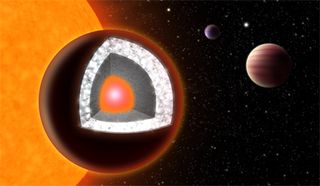Super-Earth Planet Likely Made of Diamond

Move over, Hope Diamond. The most famous gems on Earth have new competition in the form of a planet made largely of diamond, astronomers say.
The alien planet, a so-called "super-Earth," is called 55 Cancri e and was discovered in 2004 around a nearby star in our Milky Way galaxy. After estimating the planet's mass and radius, and studying its host star's composition, scientists now say the rocky world is composed mainly of carbon (in the form of diamond and graphite), as well as iron, silicon carbide, and potentially silicates.
At least a third of the planet's mass is likely pure diamond.
"This is our first glimpse of a rocky world with a fundamentally different chemistry from Earth," lead researcher Nikku Madhusudhan of Yale University said in a statement. "The surface of this planet is likely covered in graphite and diamond rather than water and granite."
55 Cancri e is the first likely "diamond planet" to be identified around a sun-like star, though such worlds have been theorized before. Planets like this are vastly different from our Earth, which has relatively little carbon.
"By contrast, Earth’s interior is rich in oxygen, but extremely poor in carbon — less than a part in thousand by mass," said study co-author and Yale geophysicist Kanani Lee.
55 Cancri e is what's known as a super-Earth, with a radius twice as wide as that of our own planet, and a mass eight times greater. It speeds around its host star, making a full orbit in just 18 hours (Earth takes 365 days). It is so close in to the star that its surface temperature reaches a scorching 3,900 degrees Fahrenheit (2,100 degrees Celsius), making it probably way too hot for life. [Oozing Super-Earth: Images of Alien Planet 55 Cancri e]
Get the Space.com Newsletter
Breaking space news, the latest updates on rocket launches, skywatching events and more!
Previous studies of this planet suggested it might actually be covered with oozing "supercritical fluids" — high-pressure liquid-like gases — seeping out from its rocks. But this idea was based on the assumption that 55 Cancri e had a similar chemical makeup as Earth, Madhusudhan said. The new findings suggest the planet has no water at all.
The revelation of the planet's diamond nature means that it could have very different thermal evolution and plate tectonics processes than Earth, which could create bizarre types of volcanism, seismic activity, and mountain formation.
55 Cancri e is one of five planets encircling a sun-like star called 55 Cancri, which lies about 40 light-years from Earth in the constellation of Cancer. This star is so close it is visible to the naked eye in the night sky.
The researchers hope to make follow-up observations of this star system to better determine the star's composition and to analyze 55 Cancri e's atmosphere. This information could bolster the idea that the planet is a diamond world.
A paper reporting the new findings has been accepted for publication in the journal Astrophysical Journal Letters.
You can follow SPACE.com assistant managing editor Clara Moskowitz on Twitter @ClaraMoskowitz. Follow SPACE.com on Twitter @Spacedotcom. We're also on Facebook & Google+.
Join our Space Forums to keep talking space on the latest missions, night sky and more! And if you have a news tip, correction or comment, let us know at: community@space.com.

Clara Moskowitz is a science and space writer who joined the Space.com team in 2008 and served as Assistant Managing Editor from 2011 to 2013. Clara has a bachelor's degree in astronomy and physics from Wesleyan University, and a graduate certificate in science writing from the University of California, Santa Cruz. She covers everything from astronomy to human spaceflight and once aced a NASTAR suborbital spaceflight training program for space missions. Clara is currently Associate Editor of Scientific American. To see her latest project is, follow Clara on Twitter.
